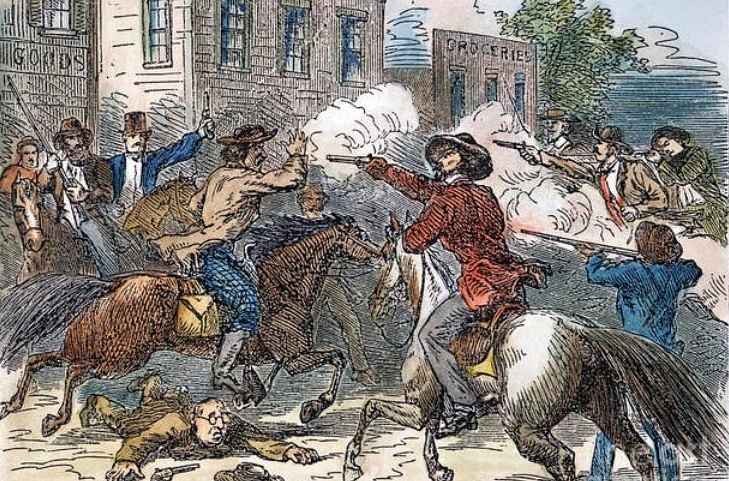






See listing of Recent and Most Popular articles on the Home Page
My World
Category: Government & Politics / Topics: Beliefs • Government • History • News • Politics • Social Issues • Social Movements • Values • Voting & Elections
Where Will the Political Violence Lead? Look to the 1850s.
Posted: November 5, 2022
In the mid-19th century, a pro-slavery minority — encouraged by lawmakers — used violence to stifle a growing anti-slavery majority. It wasn’t long before the other side embraced force as a necessary response…
Editor's Note: The threat of violence tied to the mid-term elections in 2022—cast as a "threat to Democracy" laid at the feet of right-wing extremists—has been called "unprecedented" in American (even world) history. While the situation is extremely troubling and dangerous, to call it unprecedented is true only in the narrowest sense, looking at the specific characteristics of the present situation. To anyone who has studied American (and world) history, political violence—in word if not deed—is nothing new. Following is an excerpt of a piece by Joshua Zeitz that appeared in Politico on October 29. You will find a link to the full article, with related material, at the bottom of this page.
As stated in other articles about voting and elections on SeniorLifestyle, our appeal is to turn off the bellows of fear and hatred that fans the flames of division. Violence is undeniably part of America's political DNA, but is force a necessary remedy, as Zeitz suggests was necessary before? Does violence need to sabotage the American "experiment" and derail us from continuing on the long, hard road to a more perfect union?
Early Friday morning, an intruder broke into the San Francisco home of House Speaker Nancy Pelosi and bludgeoned her husband, Paul Pelosi, 82, on the head with a hammer. . . . .
This is the United States of America in 2022. A country where political violence — including the threat of political violence — has become a feature, not a bug . . . [see full article for a list of characteristics and concerns, with links to examples]
And of course, January 6, and subsequent efforts by Republicans and conservative media personalities to whitewash or even celebrate it.
Pundits like to take refuge in the saccharine refrain, “this is not who we are,” but historically, this is exactly who we are. Political violence is an endemic feature of American political history. It was foundational to the overthrow of Reconstruction in the 1870s and the maintenance of Jim Crow for decades after.
But today’s events bear uncanny resemblance to an earlier decade — the 1850s, when Southern Democrats, the conservatives of their day, unleashed a torrent of violence against their opponents. It was a decade when an angry and entrenched minority used force to thwart the will of a growing majority, often with the knowing support and even participation of prominent elected officials.
That’s the familiar part of the story. The less appreciated angle is how that growing majority eventually came to accept the proposition that force was a necessary part of politics.
The 1850s were a singularly violent era in American politics. Though politicians both North and South, Whig and Democrat, tried to contain sectional differences over slavery, Southern Democrats and their Northern sympathizers increasingly pushed the envelope, employing coercion and violence to protect and spread the institution of slavery.
It began with the Fugitive Slave Act of 1850, which stripped accused runaways of their right to trial by jury and allowed individual cases to be bumped up from state courts to special federal courts. . . . Most obnoxious to many Northerners, the law stipulated harsh fines and prison sentences for any citizen who refused to cooperate with or aid federal authorities in the capture of accused fugitives. Southern Democrats enforced the law with brute force, to the horror of Northerners, including many who did not identify as anti-slavery.
The next provocation was the Kansas Nebraska Act of 1854, which effectively abrogated the Missouri Compromise and opened the western territories to slavery. It wasn’t enough that Democrats rammed through legislation allowing the citizens of the Kansas and Nebraska territories to institutionalize slavery if they voted to do so in what had long been considered free territory. They then employed coercion and violence to rig the territorial elections that followed. . . .
The violence made it into Congress. When backlash against the Kansas Nebraska Act upended the political balance, driving anti-slavery Democrats and Whigs into the new, anti-slavery Republican party, pro-slavery Democrats responded with rage. In 1856, Charles Sumner, a staunch anti-slavery Republican, delivered a speech entitled “The Crime Against Kansas.” In response, a Democratic congressman from South Carolina beat him nearly to death on the Senate floor with a steel-tipped cane — not entirely dissimilar from the hammer-wielding conspiracy theorist who attempted to murder Paul Pelosi Friday.
“Bleeding Sumner,” as the outrage came to be known, was not a one-off. Pro-slavery congressmen began showing up armed on the House floor. They threatened their Northern colleagues with whippings and beatings. They talked openly of civil war and rebellion.
In some ways, none of this was new. Pro-slavery forces had long been violent and anti-democratic. When abolitionists in the 1830s began sending anti-slavery literature to Southern slaveholders, the pro-slavery forces tried to ban them from using the postal service. They destroyed the printing presses of abolitionist publishers and, in 1837, famously lynched Elijah P. Lovejoy, an abolitionist clergyman — after dumping his press in the river.
But the 1850s were different — not just in the intensification of pro-slavery violence, but in the reaction it elicited.
Southerners had long assumed that their Northern antagonists would buckle and fold. Anti-slavery men and women tended to draw their faith from evangelical Protestantism, which favored moral suasion over coercion. They were pacifists by nature. They seemed unlikely, when faced with threat and violence, to fight back. . . . .
Armed anti-slavery mobs increasingly proved willing to engage in standoffs with federal officials. Outside Christiana, Pennsylvania, a Maryland slaveowner and his son, accompanied by armed marshals, showed up at a farmhouse and imperiously demanded the return of a Black man whom they claimed was their runaway slave. Local residents, Black and white alike, engaged in a gun fight with the “man stealers,” leaving one of them dead and two others wounded.
Something changed in the tenor of anti-slavery rhetoric as well. Frederick Douglass, a former enslaved person and lay preacher, declared that he was a “peace man,” but white men who willingly acted as “bloodhounds,” hunting down human beings to return them to slavery, had “no right to live.” “I do believe that two or three dead slaveholders will make this law a dead letter.” . . . .
His was a minority opinion in the mid-1850s, but it was catching steam.
A new generation of leaders welcomed an eye-for-an-eye approach to keeping the western territories free. Subsidized by a group of Massachusetts businessmen and religious abolitionists, the New England Emigrant Aid Company offered material assistance to Northern homesteaders willing to relocate to Kansas to populate the state with an anti-slavery majority. . . . . By 1857 the normalization of political violence advanced so far that when a prominent abolitionist urged the Massachusetts Anti-Slavery Society to furnish material support for armed insurrections by enslaved people, even Wendell Phillips, a leading abolitionist and heretofore a pacifist, rose to agree. “I want to accustom Massachusetts to the idea of insurrection,” he said, “to the idea that every slave has the right to seize his freedom on the spot.”
It was this embrace of retributive justice and support for violent liberation that led figures like Thomas Wentworth Higginson (a Unitarian minister), Gerrit Smith (a wealthy reformer and founder of a nonsectarian church in upstate New York), Theodore Parker (also a Unitarian clergyman), and Frederick Douglass to furnish John Brown with funds for his failed attempt to organize an uprising of enslaved people. Brown, a religious zealot who came to believe that he was God’s instrument in the service of emancipation, was widely scorned as a fanatic when in 1859 he was hanged for murder, incitement of an enslaved people’s rebellion, and “treason” against the state of Virginia. Within a few short years, many Union soldiers would come to memorialize him in song as they marched through the South.
Members of Congress, too, tired of being under the Southern Democrats’ boot. When Galusha Grow, a Republican from Pennsylvania, wandered over to the Democratic side of the House floor in 1858, Lawrence Keitt of South Carolina snarled, “Go back to your side of the House, you Black Republican puppy.” Grow, a future House speaker, clocked Keitt with a right hook and sent him spinning.
In 1860 Rep. Owen Lovejoy, a Republican from Illinois and brother of the slain editor, rose to deliver a blistering anti-slavery harangue. In response, Rep. Roger Pryor of Virginia physically assaulted him, prompting Rep. John Potter of Wisconsin to intercede. Potter so thoroughly walloped Pryor that the Virginian felt compelled to challenge him to a duel . . . .
Within a year, full-blown war had broken out.
Today, political violence is on the rise. It doesn’t always emanate from the right. Several years ago, a left-wing radical attempted to gun down several Republican congressmen and nearly succeeded in killing GOP Whip Steve Scalise. But in the main, the coercion and bellicosity reside on the right. We see it in the rise of far-right, white power militias like the Proud Boys and Oath Keepers, who in some cases enjoy semiformal relationships with local Republican Party organizations and leaders. We see it in MAGA rallies, where former President Donald Trump regularly incites violence against journalists and political opponents, oftentimes with GOP officeholders and candidates standing silently beside him. We see it in the growing number of political ads in which Republican candidates brandish assault weapons and even shoot things up.
On some level, none of this is new. The United States has seen more than its share of political violence — from Redemption (the process by which white Southerners violently ended Reconstruction in the South) and Jim Crow, to presidential assassinations in 1865, 1881, 1901 and 1963. As recently as the early 1970s, bombings and sabotage were a common tool of far-left domestic terrorists. All told, between January 1969 and April 1970 there were over 5,000 terrorist bombings in the United States and 37,000 bomb threats, many emanating from the radical left, not including the attempted bombings of over two dozen high schools.
But here is the difference this time: In 1970, liberal members of the Senate didn’t march alongside members of the Weather Underground, pump their fists in the air and egg them on. They didn’t align themselves with violent extremists — court their votes, grant interviews to their underground newspapers, appear at their conferences. That’s the stuff of the 1850s, when mainstream Democrats turned away from democracy and openly embraced violence, vigilantism and treason to protect a world they saw at risk of disappearing.
The decision of so many American conservatives to embrace political violence, or the language and symbolism of political violence, is a troubling reality. We can’t have a functioning democracy if one side refuses to accept its norms and rules.
But history suggests we might have more to worry about.
Democratic violence in the 1850s ultimately led a majority of Republicans, who represented the political majority, to draw a line in the sand and enforce it by violence when necessary. If history is a guidepost, we are on the precipice of dangerous future in which politics devolves into a contest of force rather than ideas. That’s a future everyone should want to avoid.
Read the full article on Politico, with additonal links to suggested related material.
Search all articles by Joshua Zeitz
Posted: November 5, 2022 Accessed 593 times
![]() Go to the list of most recent My World Articles
Go to the list of most recent My World Articles
![]() Search My World (You can expand the search to the entire site)
Search My World (You can expand the search to the entire site)
![]() Go to the list of Most Recent and Most Popular Articles across the site (Home Page)
Go to the list of Most Recent and Most Popular Articles across the site (Home Page)
 Loading requested view...
Loading requested view...